Collation
David Badke
|
Collation |
|
David Badke |
Collation is the ordering of pages and how pages are grouped into gatherings. A gathering is a set of pages that are grouped together before being bound into a book. In the Lydgate manuscript, large sheets were folded in half, and up to five of these folded sheets were grouped into gatherings. The large sheet is called a "bifolio" (plural "bifolia"), and each half-sheet produced by the fold is called a "folio" (plural "folia"). The front side (called the "recto" side) and the back side (called the "verso" side) of each folio was normally used for writing, so each folio represents two pages in the manuscript, and a folded bifolio four pages. Folia are numbered, but pages are usually not, so the folio number is followed by an "r" for recto or by a "v" for verso. For example, the notation "23r" means folio 23, recto side, while "23v" means folio 23, verso side.
In its present form the Lydgate manuscript consists of 21 gatherings. Most of the folia have foliation numbers in black ink in the upper right corner (recto), as well as modern numbers in pencil in the lower margin near the fold. The last three gatherings do not have the black ink numbers, though most folia in those gatherings have the modern pencil numbers. There is evidence that the present foliation and gathering is incorrect; the following will discuss the collation of the manuscript in its present form. See below for collation diagrams.
The first ten gatherings present a consistent pattern. There is a gathering of 10 folia (5 bifolia), with the center bifolio being parchment and the rest being paper, followed by a single parchment bifolio (that is, gathering 1 has 5 bifolia consisting of 4 outer paper bifolio and one center parchment bifolio; gathering 2 is a single parchment bifolio; gathering 3 repeats the pattern of gathering 1; gathering 4 repeats the pattern of gathering 2; and so on to gathering 10). That the single parchment bifolio of the even-numbered gatherings is a gathering of its own and not part of another gathering is suggested by the catchphrase found on the verso side of the first folio on all of the these bifolia; this catchphrase matches the first words of the first line on the facing recto side of the second folio. It is possible that the parchment bifolia were sewn to the following ten folio gatherings.
Starting in gathering 11 the regular pattern is disrupted. Gathering 11 is a single paper bifolio; gathering 12 has two paper bifolia with a center parchment bifolio; gathering 13 is a single paper bifolio; gathering 14 is a single parchment bifolio (with catchphrase); gathering 15 has ten paper/parchment folia in the gathering 1 pattern; gathering 16 has 14 folia with the two outside folia and the center folio parchment; gathering 17 has ten paper/parchment folia in the gathering 1 pattern; gathering 18 has 12 folia with the two outside folia and the center folio parchment; gathering 19 is a single paper bifolia; and gatherings 20 and 21 are single paper folia.
Because of the damage along the folds of the bifolia it is extremely difficult to see any sewing holes, making determination of the bifolia sewing pattern problematic. No records of the collation of the sheets prior to the dismantling of the seventeenth century binding have been found; Special Collections appears not to have kept any. The pencil folio numbering may have been done by the restorer as the sheets were being separated, but this is not yet known. Assuming the present foliation is correct (which is probably not entirely true), it is possible that the presently separate paper and parchment bifolia were originally sewn to adjacent gatherings to form larger gatherings. This would have gathering 2 sewn to 3, 4 to 5, 6 to 7, and 8 to 9; gatherings 10 through 13 or 14 may have been sewn together. It is also possible that the sheets were not originally sewn into gatherings or bound at all.
Further evidence of the collation (at least in the seventeenth century binding) comes from the impression of paper grain on many of the parchment sheets. Most of the parchment surfaces that were in contact with paper surfaces have parallel horizontal markings that match the laid lines found on the paper sheets. These markings were probably formed when the parchment was wet; they are most distinct in the damaged areas of the parchment and along the bifolio fold. The markings occur only on the parchment surfaces that would have been in contact with paper given the present foliation of the manuscript; no such markings have been found where paper and parchment should not have been in contact. This indicates that the present collation is probably the same as it was in the seventeenth century binding, and that the foliation (the black ink numbers in the top right corner of the folia recto) is most likely from that time (or before) as well.
These diagrams indicate the manuscript's present gatherings. The lines are bifolia, showing how the sheets were folded and grouped. The first number to the right of the lines is the folio number. The second number plus letter is the watermark type (if any). The letter m above or below a line indicates the mould side of the paper sheets.
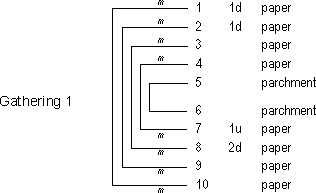 |
|
|
|
|
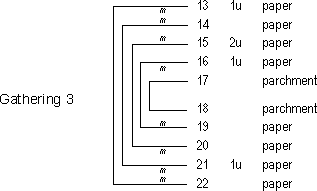 |
|
|
|
|
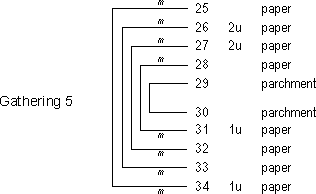 |
|
|
|
|
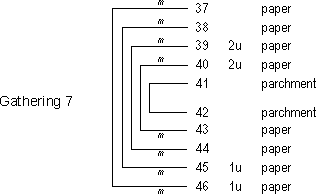 |
|
|
|
|
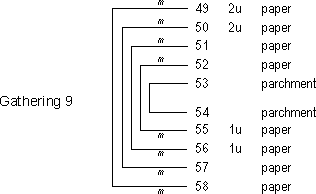 |
|
|
|
|
|
|
|
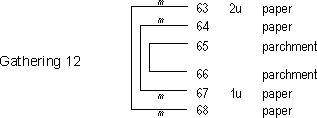 |
|
|
|
|
|
|
|
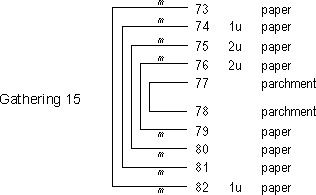 |
|
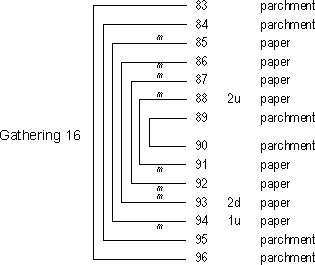 |
|
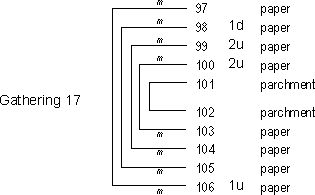 |
|
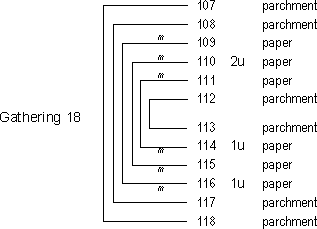 |
|
|
|
|
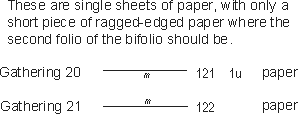 |
|